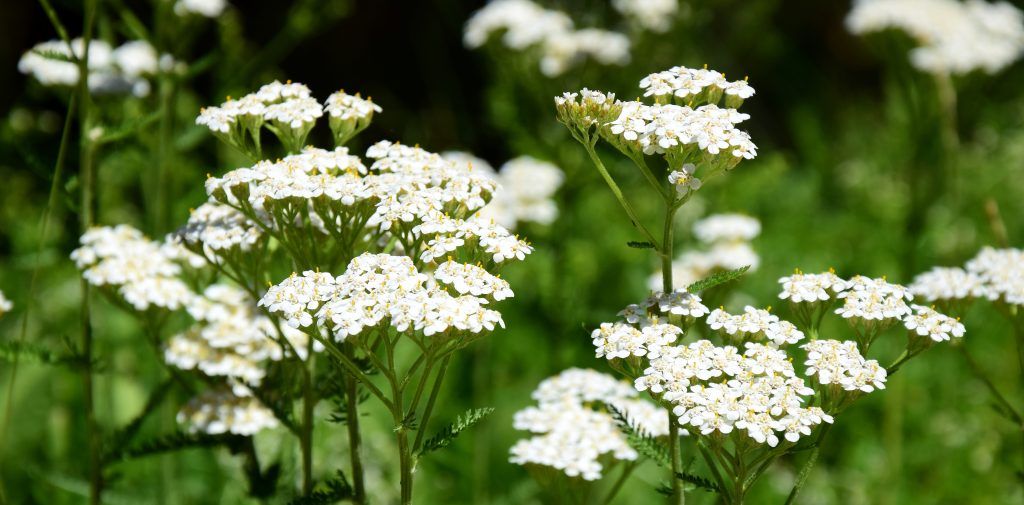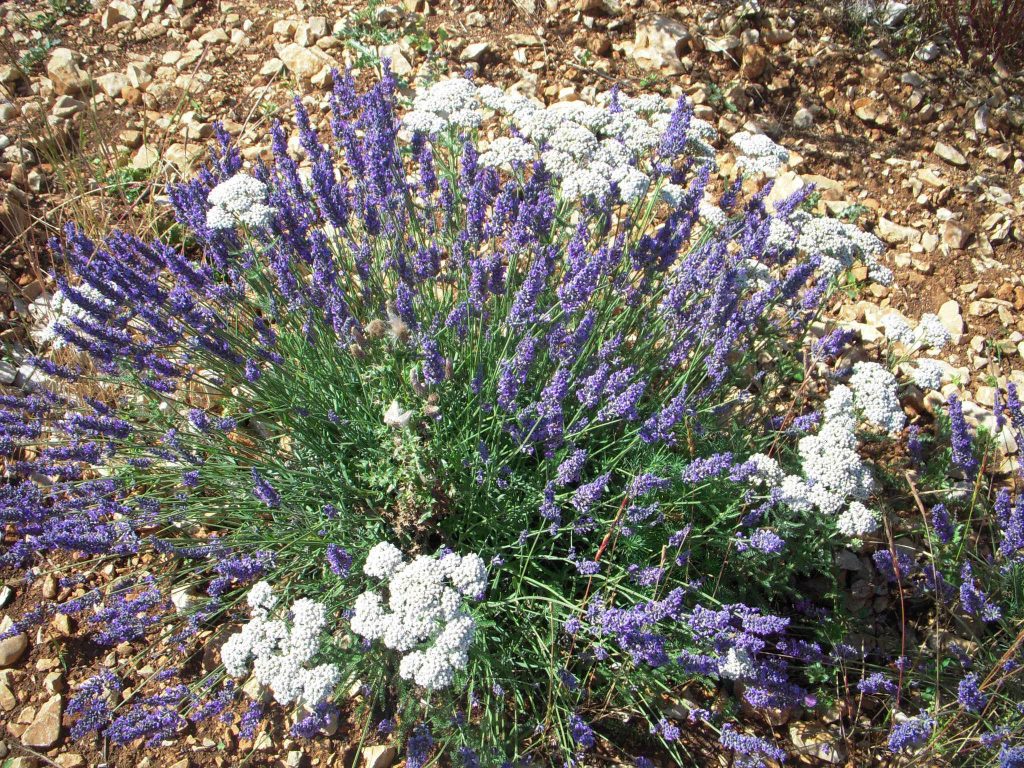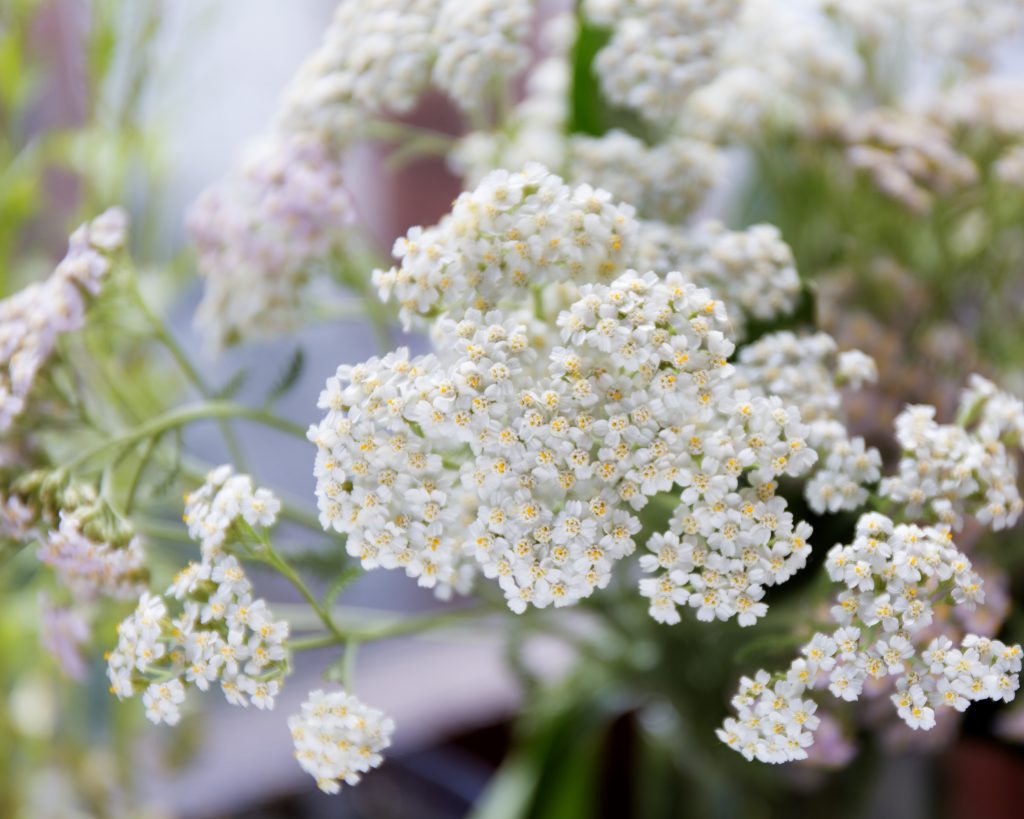Yarrow, with its botanical name Achillea millefolium, is a perennial medicinal plant popular throughout Europe. The Latin name goes back to the Trojan hero Achilles who came to Troy in search of the king of the Mysians, Thelephos. He injured Telephpos on the thigh, and healed the wound with a medicinal plant, which was later described as Yarrow. Therefore it is sometimes called the ‘soldiers’ herb’ – and even today it serves for curing wounds, but also many other ailments. Historically, Yarrow has been reported and used as a herbal remedy in many different cultures around the globe. A large number of scientific investigations have been made on it over the last decades.
Yarrow belongs to the family of Asteraceae or composite plant family and can reach a height of about 80 cm blossoming from June to October. The leaves are tender and feather-like and thus very numerous – as expressed in the Latin term ‘millefolium’ which means thousand-leaved. The strong stalk is adorned on top by a paniculate umbel with white or rose blossoms showing in their midst a slightly yellowish colour. Yarrow can be harvested from April to September.
The essential oil of Yarrow is obtained through steam distillation of the dried herb. 250kg yield an amount of 1 litre of the oil. The fragrance is soft, slightly spicy and astringent, and the colour of the oil dark blue or green due to the presence of chamalzulene, a sequiterpene compound. The essential oil is produced mainly in France, Hungary and Bulgaria.
In China Yarrow is closely connected with mythology. The substance for the ‘I Ching’ oracle is obtained from the stalks of Yarrow representing a scholar.
In Europe, in addition to its healing benefits, Yarrow has a long traditional and spiritual significance. In the Middle Ages for example on August 15th bunches of Yarrow were picked, consecrated and hung on the door to ward off plague as well as witches.
The main bio-chemical compounds of Yarrow are alpha Pinene, Bornyl Acetate, Borneol, beta Pinene, Camphene, Cineole, Camphor, Chamazulene, gamma Terpinene, isoartemisia Ketone, Limonene, Sabinene and Tricyclene.
This rich list of components already indicates that Yarrow’s properties must encompass a large scale of possibilities.
Numerous benefits of the essential oil
Here is a list of multiple therapeutic benefits of Yarrow oil. Yarrow is
- Anti-inflammatory: The oil is capable of helping successfully with inflammation of any kind.
- Useful in purifying the nasal and respiratory tracts in case of colds
- Calming disturbances of the metabolic system induced by overeating food difficult to digest, or if the circulatory system is affected by some toxic substances like venom or narcotics that have entered the blood stream.
- Anti-rheumatic: Being effective in treating circulation problems it is helpful with rheumatic and arthritic diseases too. It improves the circulation and consequently the uric acid is prevented from getting deposited in the joints and muscles. Thus it supports healing of rheumatism and arthritis .
- Anti-septic: Anti-septic products like creams and lotions offered on the market can scarcely correspond to the effectiveness of this oil. It protects wounds from getting septic or catching other bacterial infections. The chamazulene contained in the oil is the substance preventing injuries wounds from getting inflamed. It creates a protective layer on the wound, thereby mobilizing the blood platelets and leucocytes to work at the affected area, keeping control of the invasion of microbes. In addition to this the oil possesses bactericidal and fungicidal capabilities.
- Anti-spasmodic, decongestant: Spasms can cause a lot of dangerous conditions in the body. Contractions in the respiratory system can lead to serious and permanent coughs causing unbearable convulsions if affecting the nervous system. Spasms of the intestinal tract may result in severe pains within the abdominal region and the patient may suffer from cramps in the muscles. Yarrow is also beneficial for the urinary tract and due to its hormone balancing potential also a good prostrate decongestant.
- Astringent: The astringent feature for example helps the the gums and stabilizes the teeth.
- Beneficial for the hair follicles, beautifies the hair and acts against hair loss.
- Good for ageing skin thereby resulting in the face looking younger and is used against weakness of the connective tissue.
- Protective in case of bleeding or haemorrhage by producing subtle contractions in the blood vessels.
- Carminative: The essential oil releases gases from the intestines caused by flatulence. It has an excellent influence on digestion as it stimulates the production of digestive juices like acids and bile and supports the health of the liver and the metabolic organs as a whole. Yarrow is a traditional medicinal herb for treatment of loss of appetite and dyspeptic complaints.
- Cicatrisant: It has excellent effects in respect to scars, injuries and marks left by wounds, acne, pimples etc.
- Diaphoretic: The essential oil of Yarrow intensifies perspiration and relieves the body of toxins, extra salt and water resulting in cooling down the body and reducing fever.
- Expectorant: Yarrow unblocks a clogged nose, bronchi and chest and frees them from phlegm. It proves its healing powers in case of cold and is wholesome when a coughing fit occurs.
- Emenagogue: Failing menstrual flow can be reactivated with aid of this essential oil and be stimulated to occur regularly. Apart from that other troubles often happening during the menstrual phase like headache, tiredness, abdominal pains and nausea can be relieved through utilizing the oil. It can also help to prevent early menopause.
- Hypotensive: This property of Yarrow is able to bring down the blood pressure thus being beneficial to those suffering from hypertension.
- Tonic: The whole physical system is toned up by using this essential oil. It takes care of decomposing food and absorbing nutrients and thereby activates and energizes the metabolic functioning: It strengthens the liver, stomach and intestines. It supports healthy excretion, handles proper endocrinal secretions of hormones and enzymes, helps with relaxation of the nervous system and reinforces the immune system.
- Tranquilizing: Yarrow tranquilizes nerves and muscles and is helpful during periods of intense physiological and psychological transition. In case of insomnia and too much stress the essential oil may be of help and bring about a deep and relaxing sleep due to the nerves, brain and muscles being allowed to recover.

A few recipes
Bleeding gums (Dr. Telphon)
- Cistus ladaniferus: 1 drop
- Yarrow: 1 drop
- Geranium: 1 drop
Apply locally using a cotton swab. The application can be renewed several times a day.
Allergic eczema (Dr Telphon)
- Yarrow: 1ml
- Roman Chamomile: 1ml
- Lavender officinalis: 1ml
Carrier oils
- Apricot Kernel: 10ml
- Sweet almond: 10ml
- Sesame: 10ml
- Borage or Jojoba or Wheat Germ: 20ml
Apply the mixture morning and evening to the lesions
Ageing Skin (Dr Telphon)
- Yarrow: 1ml
- Helichrysum: 1ml
- Carrot: 1ml
- Carrier oils
- Apricot kernel: 15ml
- Wheat germ: 15ml
- Evening Primrose: 10ml
- Jojoba: 10ml
- Borage: 10ml
Apply this preparation morning and evening to the skin
A few thoughts on the Asteraceae family
Yarrow belongs to the family of the ‘Star-Flowers’, the Asteraceae. This group has its history in many ethno-medicinal traditions, specifically in Anthroposophic medicine, Homeopathy, ancient Greek medicine etc.
Scientists have found the oldest known member of this family in a nearly 50 million-year-old fossil flower.
“That means that the family is not younger than this; it could be older,” said Jorge Crisci, a botanist at the Museum of La Plata in La Plata, Argentina, and one of the study’s authors says: “This can help us find out the key of the success of the family.”
Cf. http://www.nytimes.com/2010/09/28/science/28obflower.html?_r=0

Studies have shown that Asteraceae are effective on numerous levels of our psycho-physiology, specifically on our respiration and post-operative injuries.
Also, not to forget, Asteraceae are considered to be one of the most important families of allergenic plants in Europe.
(Cf. Remedies Containing Asteraceae Extracts: A Prospective Observational Study of Prescribing Patterns and Adverse Drug Reactions)
They are the ‘Stars’ = lat. astera
The well-defined symmetry of the flowers of this group speaks for itself. A star flower is not just ONE flower, but many flowers in ONE. The petals around the centre are in a sense ‘fake’ indicators – as if we have to do with one single flower. But looking nearer, we see that we have a collection of flowers – a dense group of very small disk flowers, surrounded by a ring of larger petals.
What appear to be ‘petals’ of an individual flower, are actually individual ray flowers, and at the centre is a very dense pack of individual tiny disc flowers. In fact, the flower head in botany is called a ‘pseudanthium’ (false flower = pseudo anthemis).
This aspect of ‘one in many, many in one’ has a cosmic connotation. Star flowers are first-hand messengers for consciousness, for uplifting the mind towards a better connection with the body. We can say: They are ‘soul flowers’ – and they express a highly evolved state of evolution of the plant kingdom. Because if everything in the universe tends to a greater connectedness, the Asteraceae plants express this in a very direct and beautiful way. They are ‘mandalas’ of unity in diversity. In this sense the essential oils of this group help us to direct ourselves to the real values of healing, meaning: To discover our spiritual identity – our inner Being connected to the ‘Mandala’ of the Universe.
This aspect of a circular connected structure of numerous individuals in one has its own signature of a dynamic interaction – exactly this aspect which come into play when we consider the healing power of Mother Nature. Also in this sense: The inner spiral of the central disc flowers is structured according to the laws of the golden ratio and the Fibonacci sequence.
„The human mind is not capable of grasping the Universe. We are like a little child entering a huge library. The walls are covered to the ceilings with books in many different tongues. The child knows that someone must have written these books. It does not know who or how. It does not understand the languages in which they are written. But the child notes a definite plan in the arrangement of the books – a mysterious order which it does not comprehend, but only dimly suspects.”
Albert Einstein
And the connection with the outer and inner sun, here so beautifully expressed in a text on the Madia elegans flower from the same Asteraceae family:
„We have in Madia (an Asteracea) then, a process of concentrating solar warmth into its seed center, a gesture that is enacted each day as the Madia flower pulls in warmth from the periphery and folds into its centre.“
Cf. http://www.flowersociety.org/madia-plant-study.html
The Asteraceae flower with its self-transcending, opening up principle expressed by fragrance and often by its essential oils, has still another aspect:
The ‘curving-back’ to itself through substance or matter with its seed oil. This family has an abundance of seeds due to its many flowers – and seeds are the second phase after the floral process. They prepare the return to the ‘Earth principle’ of Nature, back to matter. As a consequence of the floral process, the ‘sulphur’ or cosmic dynamics of heat, the seeds – now no more volatile – lead back to the soil, the cold element. And the seeds will carry the fat with its fatty acids, the nourishing ‘mother milk’ for the next generation of plants and flowers to appear and withstand the challenge of a new ‘incarnation’…
„Life pours forth from a mysterious and mighty source abundant beyond all human capacity to comprehend. A large sunflower head produces over 1,000 seeds arranged in an extraordinary spiral pattern. Life is fecund.“
Cf. https://inaspaciousplace.wordpress.com/2014/05/21/eucharist-7/
And here we are in the centre of understanding the secret of essential oils and carrier oils. Both oils are the result of the thermic energy of the Sun, but at the same time they are totally opposite. As beautifully noted by Wilhelm Pelikan, a disciple of Rudolf Steiner, found of Anthroposophy:
“Volatile and fatty oils both relate to warmth, but otherwise they are polar opposites. In volatile oils, substance separates out into the warm element in a centrifugal process. In fatty oils, warmth turns into substance. Volatility is the essence of the former, concentration the essence of the latter.”
Wilhelm Pelikan, Healing Plants, Mercury Press, Spring Valley, NY, 1988, pp 37-38
So then, the rich presence of seeds in the Asteraceae family, the dynamics of their Fibonacci sequence, their star-like signature etc. are certainly indicators of a high ‘spritual’ energy of this group based also on the strong presence of ‘alternating circuits’ – here for example under the principles of: One and many, Sun and Earth, volatile-fragrant and substance-based, tender and stout… The higher the interplay of opposite values is in Nature – and in us – the stronger is the evolutionary challenge, but also the strength, the intention, the dynamics, the power of integration. These values are part of the ‘astral body’ in man, values of ‘letting go’ via the harmonization of opposites.

Back to Yarrow
Perhaps today we would like to take an additional look at this plant concerning its spiritual significance. Everything noted before is well expressed in Yarrow, already in its outer appearance when comparing the strong stem and the fine filigree-like leaves.
Yarrow in its astral power is able to banish sadness, melancholy, self-pity and calm down overexcited emotional states. On the one hand the amazing very fine leaves may hint at its rich healing energies whereas on the other hand they also may symbolize many necessary steps to take towards one’s spiritual fulfilment. And then these leaves… nourished by a strong stalk, medullary inside, carrying the necessary nutrients for the different parts of the herb. This stem may symbolize a strong will-power taking care of the complexity and tenderness of many steps expecting to be cultivated by loving attention in order to be crowned in the end by a beautiful flower – a flower of light.
Keeping these aspects in view, Yarrow in its outer appearance also represents the spiritual path of man and his growth towards conscious awareness. It is always fascinating to see a plant in its all-encompassing, unique significance and looking at its beneficial activities on all levels manifested in the universe which is a principle of Mother Nature. Yarrow in its abundant healing energies certainly occupies a very special place among the medicinal herbs.
Maybe, in this context, we remember these words of Rudolf Steiner on cancer:
“(…) Tumourous formations of every kind (…) arise primarily from the actual enmity of certain processes within the physical body, against the action of the etheric (astral) body; these processes rebel as it were, so that the etheric body ceases to act in certain regions of the physical body. The etheric body, however, has very great powers of regeneration and the methods of spiritual science reveal that if it is possible to remove the hindrance and to expel the inimical action, the tumour can be overcome.”
Rudolf Steiner
So, a strong ‘astral’ plant can reinforce our astral body and become a ‘healer of many wounds’. And a strong ‘astral plant’ will always excel in a strong presence of the ‘sulphur’ element, a strong flower with a strong ‘Sun’ in its centre…
„Yarrow (…) brings sulphur into play, fixing other minerals into soluble forms, and correcting weakness of the astral body.“
Rudolf Steiner
And this is one of the secrets of essential oils: The world of matter, the world of the minerals (Sal) becomes soluble in them through the influence of Sulphur or Agni, if we want to use the Ayurvedic term. Flowers are the heat organs of the plant, exposed maximum to the influence of the Sun, Moon and Stars. They ‘drink’ the light, day and night, and we absorb this light with the help of their essential oils, ‘day and night’. And this ‘liquid light’ full of ‘Ojas’ or ‘Prana’ (Ayurveda) has in each essential oil its indvidual colour and radiance.
“It is precisely this Sulphur that gives every plant its special indviduality. The Sulphur is always that which is truly individual, the soul, its essence. This is the reason why these oils are called essential oils.”
Manfred Junius, “Spagyrics, the Alchemical Preparation of Medicinal Essences” by Manfred Junius
Conclusion
To conclude, we can say that Yarrow fixes beautifully the opposition of forces in Nature into a subtle form of healing energies. And this gives Yarrow – due to its amazing polymorphism – such a rich curative power – especially in its essential oil and in the richness of its bio-chemical compounds. It is certainly also due to their high degree of anti-oxidant capacity that Yarrow has such a wide diversity of curative effects.
An amazing essential oil with a strong future for the world of Aromatherapy.